Chiloé is an undiscovered enchantment blessed in nature, rural landscapes, delicious seafood and colourful UNESCO churches.
This windswept archipelago is located in the south of Chile and is the largest island in the country.
Arriving from the high urban sophistication that is Santiago, we immediately noticed the distinctive changes in architecture. Colourful houses sit on stilts along the water edges, covered by traditional wood shingles, which is also the theme for many stylish small hotels and restaurants dotted around the island’s capital, Castro.
But perhaps, more striking are the iconic wooden churches, 16 of which are UNESCO world heritage sites found all around the island.
The rich culture, friendly Chilotes (the name given to locals) and peacefully stunning nature, give this isle a truly distinctive identity in South America.
Chiloé Travel Guide
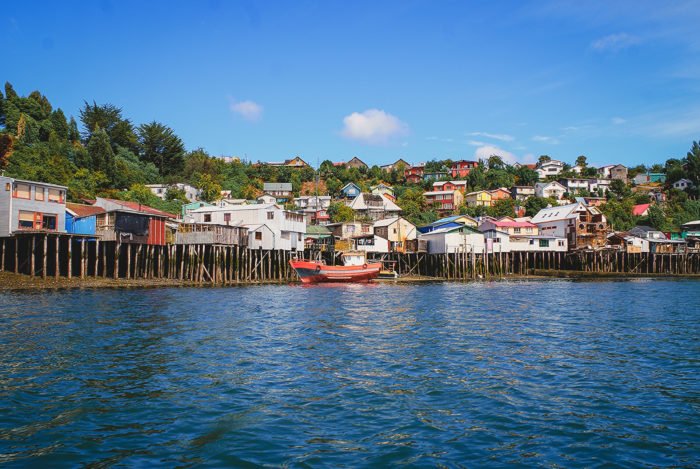
Photo: Atilio Leandro CC BY 2.0
What to do in Chiloé
Castro
Castro is the cosy capital of the Chiloé Province. It is home to the UNESCO San Francisco Church located next to the main plaza, just look out for the flamboyant yellow coloured building and you’ll see it. This unconventional visual delight was built in 1912 to replace an earlier church that had burnt down.
Once you’ve admired the neo-Gothic and classical architecture of the church, wander through the Plaza de Armas where you’ll find a handcraft fair selling all sorts of wonderful items. The plaza hosts the Festival Costumbrista, a celebration of Chilote customs, food, and crafts so if you’re around in February, head down.
It’s best to see the town on foot, so take a stroll from Plaza de Armas and walk up the hill towards the mirador (viewpoint) to get a bird’s eye view of the city’s unique and colourful timber palafitos houses. These stilt supported homes were once the dwellings of most of the fishermen of Southern Chile.
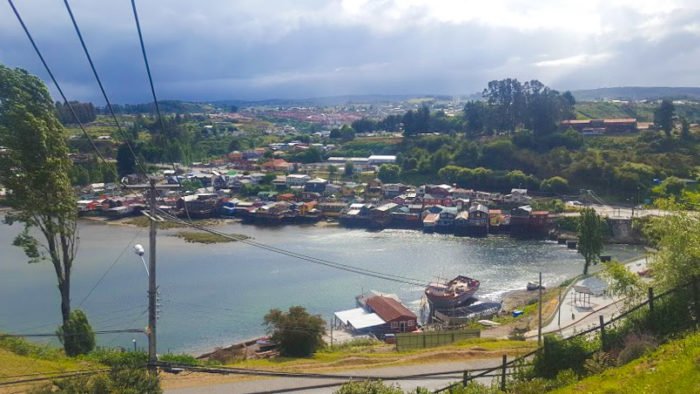
Ancud
Ancud, the former capital of Chiloé, was an international port until the 20th century. Today it is a mix of traditional Chilote buildings, docks and plazas, government buildings and the Museo Regional de Ancud, which contains exhibits about Chilote culture and mythology.
Other places of interest include the fish, vegetable and handicraft market, the harbour, and the historical centre with its shingled houses.
Muelle de Las Almas (Dock of Souls)
Inspired by the traditional belief that the souls of the dead sail away, a local artist has marked native culture by installing a wooden sculpture, a bridge, near the small village of Cucao. The views from the cliff are remarkable and if you can catch the sunset there, you’re in for a treat.
To get there either rent a car (45-minute drive) or catch a local bus to Cucao (1.5-hour ride). The bus will drop you outside a restaurant called Terrasa de Cucao from where you need to catch another bus to Muelle de las Almas (30-minute ride and the last bus in that direction leaves at 3 pm).
The rest is a scenic 45-minute hike through pleasant woods and fields, taking you to the cliffs and a picturesque bridge.
The last bus departs Muelle de las Almas is at 5.30pm.
Don’t miss it!
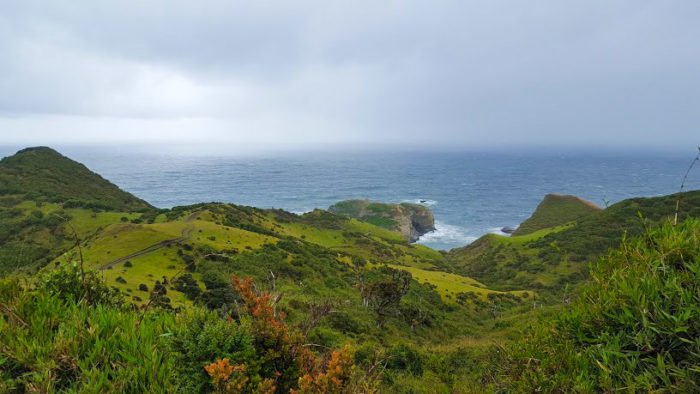
Chiloé National Park
If you are going to Muelle de las Almas, then you will pass this place, so make sure you fit it into your schedule. Get lost in this bosky forest and admire a variety of Chilote wildlife, including 110 different birds, foxes and the world’s smallest deer, the pudú. Nature lovers will appreciate this spot.
UNESCO World Heritage Churches
Perhaps one of the things Chiloé is most famous for are its unique churches.
Many were constructed almost entirely from native wood in the Chilote architecture style with each one having its own individual colour scheme.
There are many churches in and around the island and UNESCO has recognised 16 of them for their unique cultural value.
Everything seems to be connected to the sea in Chiloé and the churches are no exception, shipbuilders constructed many of the wooden churches and the designs reflect the techniques of their craft.
You probably won’t manage to see all of them, but try to get to Tenaún for one of the prettiest ones on the island which has a beautiful setting overlooking the ocean.
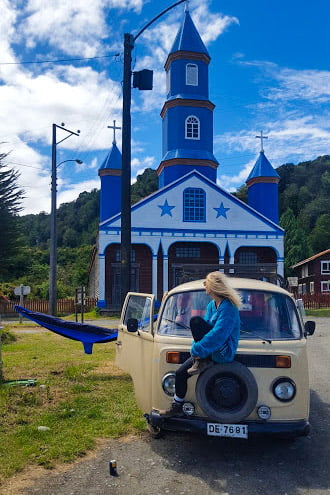
Cascadas de Tocoihue
The gorgeous waterfalls of Tocoihue are set in a thick green forest and are unique on the island. If you are heading to Tenún, make sure to stop off here.
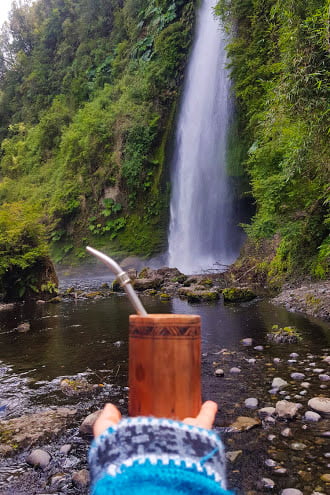
Isla de las Almas Navigantes
Located 64 kilometres from Castro, in the town of Quemchi, is a tiny island where the souls of sea navigators and locals are laid to rest in a small cemetery.
The path to the all green island resembles a painting, with a beautiful bridge leading to this patch of land is perfect for nature lovers.
The island inhabits a variety of birds, such as the Kinffisher and the Tiuque as well as an abundance of flora. It’s perfect for a short walk.
The place can be explored in just 10 minutes.
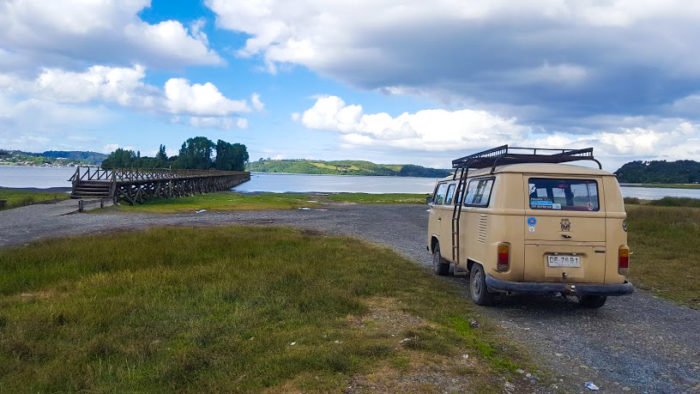
Kayaking
Kayaking is a great way to explore the sea channels of the island. Many agencies offer the activity, which takes you around the calm lakes and lagoons as you visit the villages around the island. If you love the water and tranquillity, this one is for you.
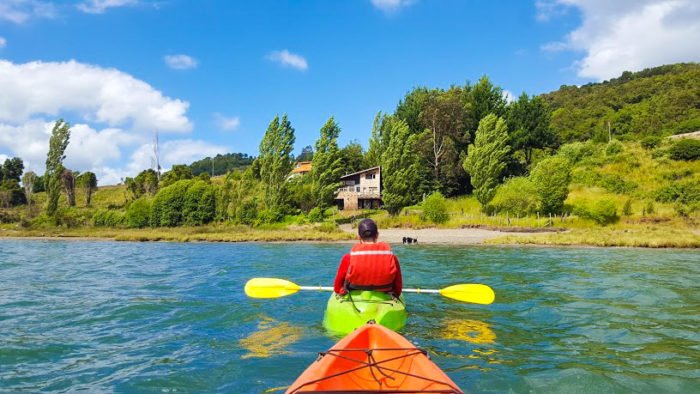
What to eat in Chiloé
Chiloé is famed for its hundreds of colourful potatoes, and on this island, they really work well with what nature has gifted them.
Earth ovens are particularly used in Chilote cuisine with hearty portions of shellfish and potatoes.
One traditional dish that’s cooked in this way is curanto; seafood, meat and potatoes are placed on hot coals in a hole dug in the ground, and then covered with large leaves and left to steam.
Seafood is obviously not to be missed here, one of my favourites, ceviche, is prepared to perfection in Castro.
Fortunately, the best place to have this delicious dish also happens to be the cheapest!
Go to Feria Lillo Market in Castro and it will only set you back CLP$3000.
My favourite was the salmon with prawns, but there are many options to choose from. Our friend also bought a small bottle of white wine from a corner shop across the road to complement the ceviche, and that it did!
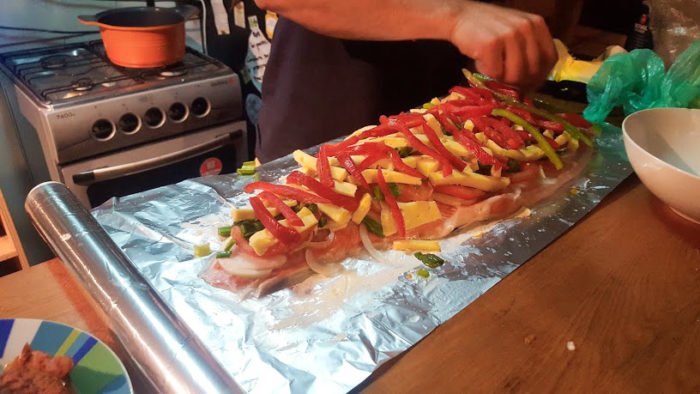
Another traditional must try, and this one you can easily do yourself, is salmon pizza! They call it Cancato. No, not pizza topped with salmon, the salmon serves as the base of the pizza! That’s right, a healthy pizza!
Well… sort of, at least until you smother it with cheese. We cooked this at our friend’s place and topped the fish with chopped onions, garlic, red peppers, tomatoes and lots of parmesan (you can probably top it with whatever ingredients you want), pop it in the oven for about 15-20 minutes and voilà.
Where to stay in Chiloé
Castro is the main city on the island, so it’s a good place to base yourself. There is a variety of accommodations to choose from, so it really depends on what you’re after.
This slightly upscale hotel will allow you to enjoy Chiloe complete with a hot tub and sauna. Every room provides cable TV, a private bathroom, and there is free onsite parking.
Situated in Castro, it is one of the best-located hostels. It offers free private parking and a cosy atmosphere for guests, with a continental breakfast included.
Cabins
In a place like Chiloé, lodgings in a cabin are most fitting. We stayed with a friend who had built his own perfect cabin, completely immersed in nature and overlooking the water. It’s the most peaceful and tranquil place to stay.
A lot of the cabins are located on or near the water, completely surrounded by nature and can be found on Airbnb.
If you’ve never used AirBnB before, you can get a discount here.
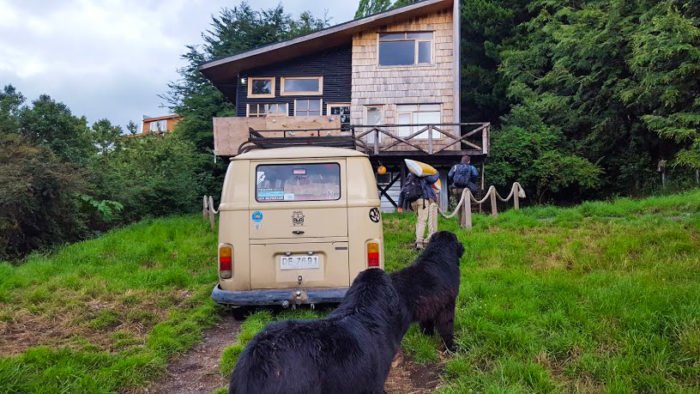
How to get to Chiloé
Puerto Montt is the closest mainland bus station to Chiloé, located 1000 km from Santiago. It’s a 13-hour bus journey or 1 hour 50 minutes by plane.
From Puerto Montt, you need to travel a further 90 km southwest towards Pargua, where you have to take the ferry across the Canal de Chacao to get to Chiloé (25-minute ferry ride).
Santiago to Puerto Montt by car takes approximately 13 hours, take Route 5 south to Puerto Montt, and then head southeast toward Pargua.
Travel tips for Chiloé
- Hire a car – it’s probably the best and most convenient way to see the island
- The best time to go weather-wise is January-March (these are the warmest months)
- The coldest months are July-October
- The rainiest months are May-August

Beautiful! Was looking out for some useful information about Chiloe and I got one here.
Thanks for sharing! The captures are lovely!
Glad you found it useful 🙂
Was looking out for some useful about Chiloe.
Thank you 🙂
Thanks for your blog post, it was actually one of the few that was helpful when I was planning my trip to Chiloe. I checked out a lot of the places you mentioned and wrote up my own little guide hoping it can help others.
I found Chiloe not as you describe it as “an undiscovered enchantment blessed in nature, rural landscapes” but as a massively over populated and over developed travesty. It has succumbed to rampant urban and rural development and is filthy, which is a pity. It probably was beautiful 20 yrs ago.
Thank you! I went to Castro from Puerto Montt by bus – could not have been more comfortable and costs only around 5000-6000CLP (around 8 dollars) for a 3h ride..
I worried a little bit for going by bus after I read your article but there are buses connecting several little cities on the island and there is absolut no problem to travel the island by bus!